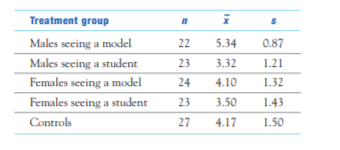Although consumers often want to touch products before purchasing them, they generally prefer that others have not touched products they would like to buy. Can another person touching a product create a positive reaction? Subjects were given instructions to contact a sales associate at a university bookstore who would provide them with a shirt to try on. When meeting the sales associate, subjects were told that there was only one shirt left and it was being tried on by another “customer.” The other customer trying on the shirt was a confederate of the experimenter and was either an attractive, well-dressed professional female model or an average-looking female college student wearing jeans and a tee shirt. Subjects, who were either males or females, saw the confederate leaving the dressing room, where the shirt was left for them to try on. There was also a control group of subjects who were handed the shirt directly off the rack by the sales associate. Thus, there were five treatments: male subjects seeing a model, female subjects seeing a model, male subjects seeing a college student, female subjects seeing a college student, and the control group. Subjects evaluated the product on five dimensions, each dimension on a 7-point scale, with the five scores then averaged to give the subject’s evaluation measure, with higher numbers indicating a more positive evaluation. Here are the sample sizes, means, and standard deviations for the five groups (a) Verify that the sample standard deviations allow the use of ANOVA to compare the population means. What do the means suggest about the effect of the subject’s sex and the attractiveness of the confederate on the evaluation of the product? (b) The paper reports an ANOVA F statistic of F 8.30. What are the degrees of freedom for the ANOVA F statistic and the P-value? State your conclusions
Although consumers often want to touch products before purchasing them, they generally prefer that others have not touched products they would like to buy. Can another person touching a product create a positive reaction? Subjects were given instructions to contact a sales associate at a university bookstore who would provide them with a shirt to try on. When meeting the sales associate, subjects were told that there was only one shirt left and it was being tried on by another “customer.” The other customer trying on the shirt was a confederate of the experimenter and was either an attractive, well-dressed professional female model or an average-looking female college student wearing jeans and a tee shirt. Subjects, who were either males or females, saw the confederate leaving the dressing room, where the shirt was left for them to try on. There was also a control group of subjects who were handed the shirt directly off the rack by the sales associate. Thus, there were five treatments: male subjects seeing a model, female subjects seeing a model, male subjects seeing a college student, female subjects seeing a college student, and the control group. Subjects evaluated the product on five dimensions, each dimension on a 7-point scale, with the five scores then averaged to give the subject’s evaluation measure, with higher numbers indicating a more positive evaluation. Here are the sample sizes, means, and standard deviations for the five groups
(a) Verify that the sample standard deviations allow the use of ANOVA to compare the population means. What do the means suggest about the effect of the subject’s sex and the attractiveness of the confederate on the evaluation of the product?
(b) The paper reports an ANOVA F statistic of F 8.30. What are the degrees of freedom for the ANOVA F statistic and the P-value? State your conclusions

Trending now
This is a popular solution!
Step by step
Solved in 2 steps with 4 images







